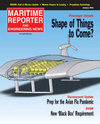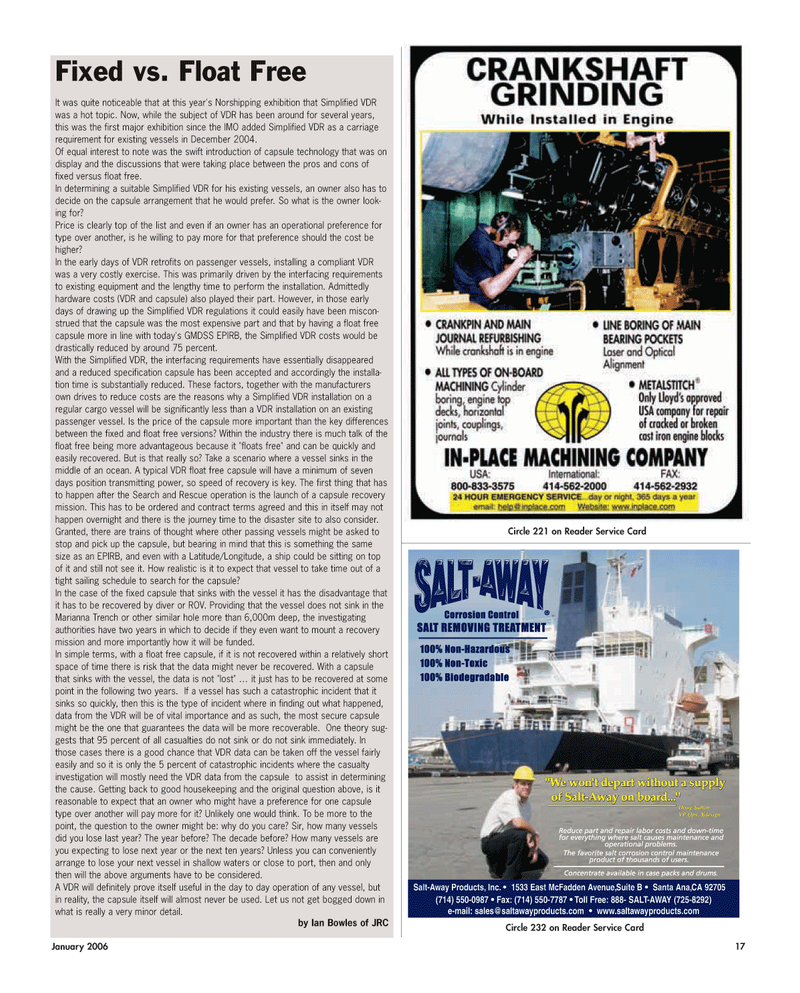
Page 17: of Maritime Reporter Magazine (January 2010)
Ship Repair & Conversion
Read this page in Pdf, Flash or Html5 edition of January 2010 Maritime Reporter Magazine
January 2006 17
Fixed vs. Float Free
It was quite noticeable that at this year's Norshipping exhibition that Simplified VDR was a hot topic. Now, while the subject of VDR has been around for several years, this was the first major exhibition since the IMO added Simplified VDR as a carriage requirement for existing vessels in December 2004.
Of equal interest to note was the swift introduction of capsule technology that was on display and the discussions that were taking place between the pros and cons of fixed versus float free.
In determining a suitable Simplified VDR for his existing vessels, an owner also has to decide on the capsule arrangement that he would prefer. So what is the owner look- ing for?
Price is clearly top of the list and even if an owner has an operational preference for type over another, is he willing to pay more for that preference should the cost be higher?
In the early days of VDR retrofits on passenger vessels, installing a compliant VDR was a very costly exercise. This was primarily driven by the interfacing requirements to existing equipment and the lengthy time to perform the installation. Admittedly hardware costs (VDR and capsule) also played their part. However, in those early days of drawing up the Simplified VDR regulations it could easily have been miscon- strued that the capsule was the most expensive part and that by having a float free capsule more in line with today's GMDSS EPIRB, the Simplified VDR costs would be drastically reduced by around 75 percent.
With the Simplified VDR, the interfacing requirements have essentially disappeared and a reduced specification capsule has been accepted and accordingly the installa- tion time is substantially reduced. These factors, together with the manufacturers own drives to reduce costs are the reasons why a Simplified VDR installation on a regular cargo vessel will be significantly less than a VDR installation on an existing passenger vessel. Is the price of the capsule more important than the key differences between the fixed and float free versions? Within the industry there is much talk of the float free being more advantageous because it "floats free" and can be quickly and easily recovered. But is that really so? Take a scenario where a vessel sinks in the middle of an ocean. A typical VDR float free capsule will have a minimum of seven days position transmitting power, so speed of recovery is key. The first thing that has to happen after the Search and Rescue operation is the launch of a capsule recovery mission. This has to be ordered and contract terms agreed and this in itself may not happen overnight and there is the journey time to the disaster site to also consider.
Granted, there are trains of thought where other passing vessels might be asked to stop and pick up the capsule, but bearing in mind that this is something the same size as an EPIRB, and even with a Latitude/Longitude, a ship could be sitting on top of it and still not see it. How realistic is it to expect that vessel to take time out of a tight sailing schedule to search for the capsule?
In the case of the fixed capsule that sinks with the vessel it has the disadvantage that it has to be recovered by diver or ROV. Providing that the vessel does not sink in the
Marianna Trench or other similar hole more than 6,000m deep, the investigating authorities have two years in which to decide if they even want to mount a recovery mission and more importantly how it will be funded.
In simple terms, with a float free capsule, if it is not recovered within a relatively short space of time there is risk that the data might never be recovered. With a capsule that sinks with the vessel, the data is not "lost" … it just has to be recovered at some point in the following two years. If a vessel has such a catastrophic incident that it sinks so quickly, then this is the type of incident where in finding out what happened, data from the VDR will be of vital importance and as such, the most secure capsule might be the one that guarantees the data will be more recoverable. One theory sug- gests that 95 percent of all casualties do not sink or do not sink immediately. In those cases there is a good chance that VDR data can be taken off the vessel fairly easily and so it is only the 5 percent of catastrophic incidents where the casualty investigation will mostly need the VDR data from the capsule to assist in determining the cause. Getting back to good housekeeping and the original question above, is it reasonable to expect that an owner who might have a preference for one capsule type over another will pay more for it? Unlikely one would think. To be more to the point, the question to the owner might be: why do you care? Sir, how many vessels did you lose last year? The year before? The decade before? How many vessels are you expecting to lose next year or the next ten years? Unless you can conveniently arrange to lose your next vessel in shallow waters or close to port, then and only then will the above arguments have to be considered.
A VDR will definitely prove itself useful in the day to day operation of any vessel, but in reality, the capsule itself will almost never be used. Let us not get bogged down in what is really a very minor detail. by Ian Bowles of JRC
Circle 232 on Reader Service Card
Circle 221 on Reader Service Card
Salt-Away Products, Inc. • 1533 East McFadden Avenue, Suite B • Santa Ana, CA 92705 (714) 550-0987 • Fax: (714) 550-7787 • Toll Free: 888- SALT-AWAY (725-8292) e-mail: [email protected] • www.saltawayproducts.com
MR JANUARY2006 #3 (17-24).qxd 1/3/2006 3:05 PM Page 17

 16
16

 18
18
